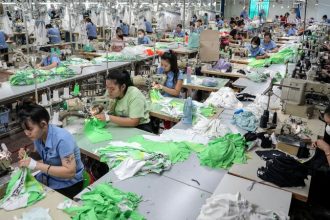Attention turned to Vietnam on Thursday following U.S. President Donald Trump’s announcement of a trade agreement with Hanoi, just days before the reinstatement of reciprocal tariffs. The new deal introduces a 20% duty on Vietnamese imports, significantly lower than the 46% tariff imposed in early April. Conversely, U.S. exports to Vietnam will remain tariff-free. Additionally, Trump indicated that Vietnam has committed to a 40% duty on goods originating from other nations that are shipped through Vietnam to the U.S.—a practice known as transshipping, frequently utilized by China to bypass trade restrictions.
Vietnam stands out as one of the few nations to secure a trade agreement with the current administration as Trump’s 90-day temporary reprieve approaches its end. Other countries are observing closely what this deal signifies for their own trade relationships with the U.S., the world’s largest economy. “What we learned from the Vietnam deal is, if anything, the tariffs are going to go up from here, not down,” noted Sebastian Raedler, head of European equity strategy at Bank of America, during an appearance on CNBC’s “Europe Early Edition.” Meanwhile, Mark Williams, chief Asia economist at Capital Economics, suggested that the outcome may facilitate negotiations for other nations. He remarked, “Other countries will feel they should be able to lock in a lower tariff rate than the 20% that President Trump says Vietnam has agreed to,” while highlighting that Vietnam approached the negotiations from a relatively weaker position due to its reliance on U.S. trade.
Potential concerns are emerging for other countries within the same economic bracket as Vietnam. Economists and strategists at Citi expressed that the agreement could spell trouble for emerging market economies, stating, “On balance, we believe there is more for EM Asia to worry about than expect gains if this deal reflects what is to come soon.” They emphasized that, while the development may reduce uncertainty and signal future agreements, the imposed 20% tariff is higher than the anticipated 10% and that the additional 40% duty on transshipped goods might necessitate similar agreements from other nations.
Citi’s analysts further noted that nations like Thailand and Malaysia could face heightened exposure compared to their emerging market peers. They added, “A separate and more punitive tariff on transshipped goods was least expected by the market,” suggesting potential repercussions for other exporters, particularly those from Korea, who have set up production facilities in Vietnam over recent years.
Experts expect numerous additional trade agreements to surface shortly, with Williams asserting that the U.S. seems inclined to establish these “rough” frameworks rather than comprehensive deals. Among the possible next candidates for trade dialogue is India, according to Trinh Nguyen, senior economist for emerging Asia at Natixis CIB. However, she cautioned that challenges in the agriculture sector might hinder progress since India “will find it hard to allow U.S. market access without domestic backlash.”
While the U.S.-Vietnam agreement indicates potential for more deals across Asia, the same may not apply to the European Union, according to Lavanya Venkateswaran, senior ASEAN economist at OCBC Bank. She commented, “The Vietnamese authorities have been clear about their intent to negotiate with the U.S., even before the reciprocal announcements were made in April,” noting that other regional economies like Indonesia and Malaysia have also expressed similar intentions. In contrast, the EU has faced challenges in its negotiations, with Venkateswaran commenting that the U.S. has publicly criticized the EU at different times. Nguyen added that the Vietnam deal highlights the complexity of achieving tariff-free conditions for Europe and suggested a likely scenario where the EU might have to accept a 10% tariff while seeking sector-specific concessions.












